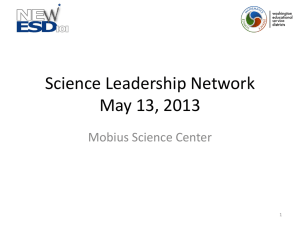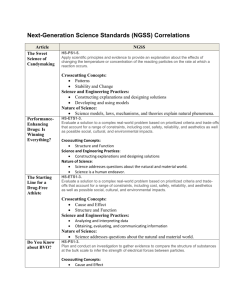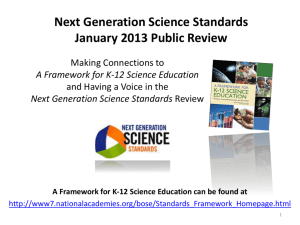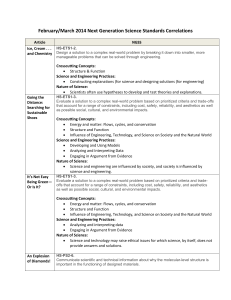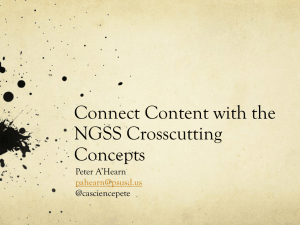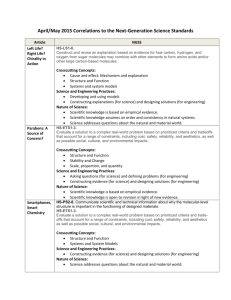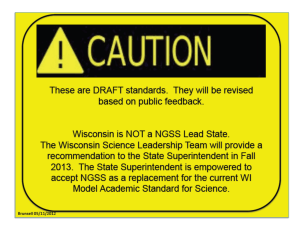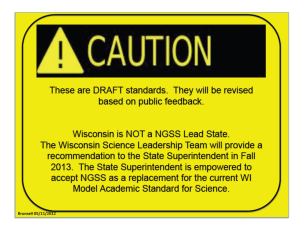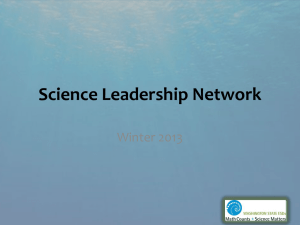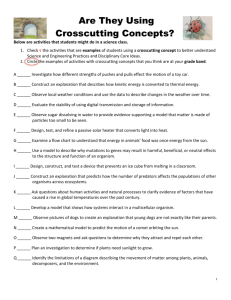SLN Spring 2013 Power Point
advertisement
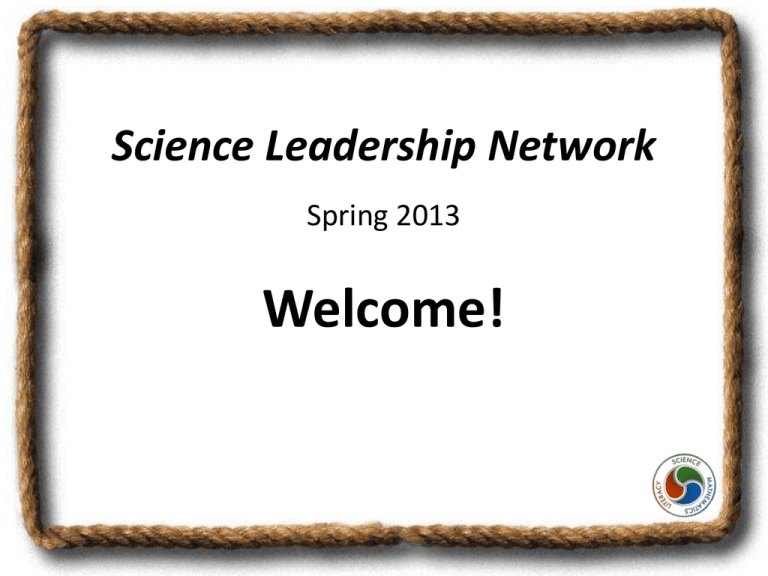
Science Leadership Network Spring 2013 Welcome! What is SLN? • Provide input to the Alliance leadership on the implementation of the science kits in their district. • Provide information in regards to the professional development needs of teachers in their district. • Act as a conduit to share science related information from the Alliance with the teachers in their district. • Serve as a science advocate within their building and district. • Assist district leadership in planning and implementing their district science plan. • Serve as a science teacher leader within the Alliance, attending SLN professional development, and then coordinating or delivering these professional development offerings within their district. Science Leadership Network Fall: Dimension 1: Science & Engineering Practices Science Leadership Network Winter: Dimension 2: Crosscutting Concepts Science Leadership Network How do Disciplinary Core Ideas, Crosscutting Concepts, and Practices of Science and Engineering integrate throughout a student’s K-12 Science educational experience? A Framework…pp.33-34 Dimension 3 Structure and Properties of Matter End Points Assessment Probe Back to the Future 2nd Grade Structure and Properties of Matter - Grade 2 2-PS1-1. Plan and conduct an investigation to describe and classify different kinds of materials by their observable properties. [Clarification Statement: Observations could include color, texture, hardness, and flexibility. Patterns could include the similar properties that different materials share.] Focus and Explore: How can you tell if something is a solid or a liquid by observing its properties? Structure and Properties of Matter - Grade 2 Structure and Properties of Matter - Grade 2 Structure and Properties of Matter - Grade 2 Reflect and Apply: • What is a second grade appropriate definition of a solid, a liquid? • Which Practices & Crosscutting Concepts were integrated into the lesson? (Use the Quick Reference guide) • What knowledge about solids & liquids do 2nd graders need to carry forward to be successful in 5th grade? Back to the Future 5th Grade Structure and Properties of Matter - Grade 5 Focus: What do you think happens to matter when it changes form? Back to the Future 5th Grade Explore: 5-PS1-1. Develop a model to describe that matter is made of particles too small to be seen. [Clarification Statement: Examples of evidence could include adding air to expand a basketball, compressing air in a syringe, dissolving sugar in water, and evaporating salt water.] [Assessment Boundary: Assessment does not include the atomic-scale mechanism of evaporation and condensation or defining the unseen particles.] Materials – – – – – Ziploc sandwich bag Seltzer tablets Water Beakers Comic Strip handout Back to the Future 5th Grade Reflection: • How do you know that the model you created fits this situation? • Which Practices & Crosscutting Concepts were integrated into the lesson? Back to the Future 5th Grade Apply: • Now that you have progressed through the elementary science concepts for this Disciplinary Core Idea (DCI), revisit the End Point Probe and affirm or revise you original thinking. • What are the implications for instruction, instructional materials, and professional development? Clean up and take a break We will resume at… Back to the Future 8th Grade Structure and Properties of Matter - Grade 8 Focus: MS-PS1-4. Develop a model that predicts and describes changes in particle motion, temperature, and state of a pure substance when thermal energy is added or removed. [Clarification Statement: Emphasis is on qualitative molecular-level models of solids, liquids, and gases to show that adding or removing thermal energy increases or decreases kinetic energy of the particles until a change of state occurs. Examples of models could include drawings and diagrams. Examples of particles could include molecules or inert atoms. Examples of pure substances could include water, carbon dioxide, and helium.] How can a model help you predict and describe changes in particle motion? Explore: 1. Construct a model “Air Thermometer”. 2. Place the model Air Thermometer in cold and warm water to investigate your claim about what happens to molecules when temperature changes. 3. Use evidence from the investigation to construct an explanation for the changes you observe. Reflection: • How did the evidence from this investigation support or not support your original explanation? • Create diagrams that show the movement and arrangement of air molecules inside the model thermometer when exposed to warm and cold water. • How would the air molecules have behaved in this investigation if they were a solid instead of a gas? Structure and Properties of Matter - Grade 8 Apply: • Now that you have progressed through the middle school science concepts for this Disciplinary Core Idea (DCI), revisit the End Point Probe and affirm or revise you original thinking. • What kinds of concepts would students need to progress through to be ready to understand the endpoint for Grade 8 – Structure and Properties of Matter? Back to the Future High School Structure and Properties of Matter - Grade 12 HS-PS1-1. Use the periodic table as a model to predict the relative properties of elements based on the patterns of electrons in the outermost energy level of atoms. [Clarification Statement: Examples of properties that could be predicted from patterns could include reactivity of metals, types of bonds formed, numbers of bonds formed, and reactions with oxygen.] [Assessment Boundary: Assessment is limited to main group elements. Assessment does not include quantitative understanding of ionization energy beyond relative trends.] Focus: How does the periodic table demonstrate atomic theory? Structure and Properties of Matter - Grade 12 Reflection: • How well did Mendeleyev’s organizing principle work? • Now that you have progressed through the high school concepts for this DCI, revisit the End Point Probe and affirm or revise your original thinking. • What Practice(s) and Crosscutting Concept(s) were integrated into this activity. Structure and Properties of Matter - Grade 12 Apply: • Think about the experiences elementary students need to have to understand the structure and properties of matter by the end of 12th grade. • Return to your probe and update it one last time. Citing my Evidence: • Chapter 9 Integrating the Three Dimensions, pp 217-240, A Framework for K-12 Science Education Integrating the 3 Dimensions Integrating the Three Dimensions How does this integrated approach affect your instruction? • • • • Grades K-2 pp.231-233 Grades 3-5 pp.233-236 Grades 6-8 pp. 236-238 Grades 9-12 pp.239-240 Back to Our Future • Create a Box and T chart comparing and contrasting the current state of science instruction with that of the future. • Use examples from your reading to contribute to your group chart. Team Reflection • What shifts might be needed to create seamless, K-12 “Ropes of Science Learning” for students in your district? • Thinking about what you experienced today, what idea would your science team like to take action on? Your Top Choices for 2013-2014 Science Leadership Network : 1.The Next Generation Science Standards 2.Common Core State Standards in Science 3.TPEP for the Science Classroom The Three Shifts of the Next Generation Science Standards • From isolation to integration • From science inquiry to science and engineering practices • From discrete science ideas to science and engineering crosscutting concepts Preparing for the NGSS • Facts about the NGSS… • Preparing for the NGSS… • Keep on doing… • Be ready to… Reminders • One for your principal, science contact person, or other person who you need to coordinate sharing of information with. • One for you and what you want to remember in August about your learning from today and the Next Gen. Science Leadership Network Thank You!
